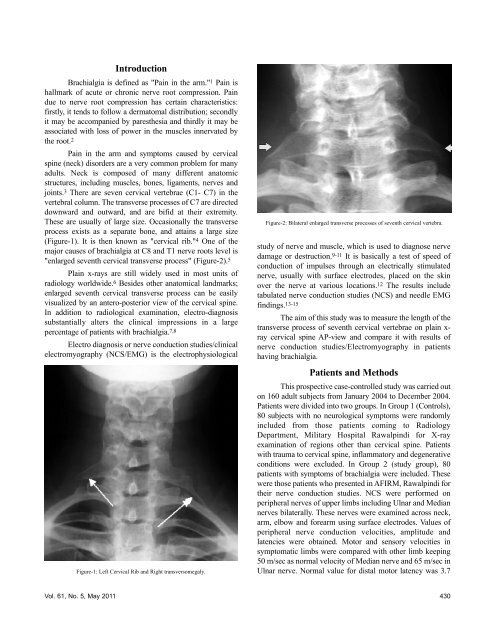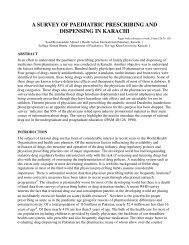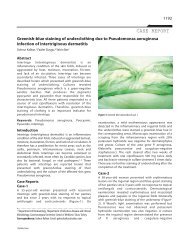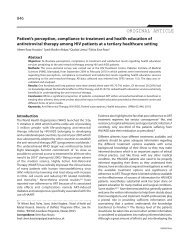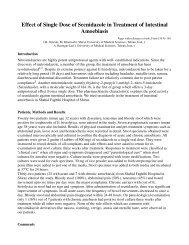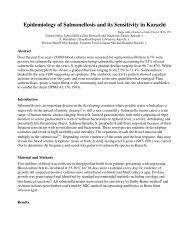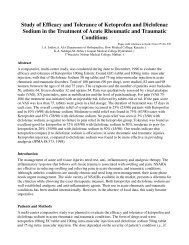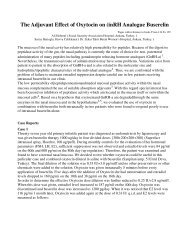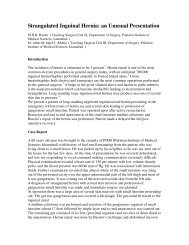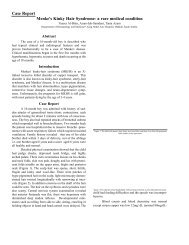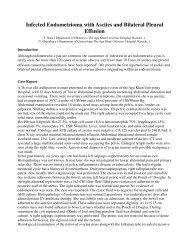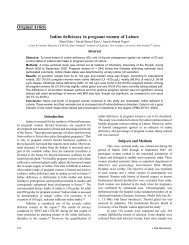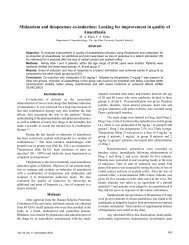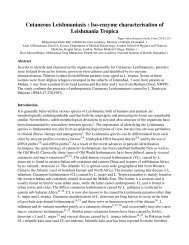Original Article Relationship of length of transverse process of ...
Original Article Relationship of length of transverse process of ...
Original Article Relationship of length of transverse process of ...
Create successful ePaper yourself
Turn your PDF publications into a flip-book with our unique Google optimized e-Paper software.
Introduction<br />
Brachialgia is defined as "Pain in the arm." 1 Pain is<br />
hallmark <strong>of</strong> acute or chronic nerve root compression. Pain<br />
due to nerve root compression has certain characteristics:<br />
firstly, it tends to follow a dermatomal distribution; secondly<br />
it may be accompanied by paresthesia and thirdly it may be<br />
associated with loss <strong>of</strong> power in the muscles innervated by<br />
the root. 2<br />
Pain in the arm and symptoms caused by cervical<br />
spine (neck) disorders are a very common problem for many<br />
adults. Neck is composed <strong>of</strong> many different anatomic<br />
structures, including muscles, bones, ligaments, nerves and<br />
joints. 3 There are seven cervical vertebrae (C1- C7) in the<br />
vertebral column. The <strong>transverse</strong> <strong>process</strong>es <strong>of</strong> C7 are directed<br />
downward and outward, and are bifid at their extremity.<br />
These are usually <strong>of</strong> large size. Occasionally the <strong>transverse</strong><br />
<strong>process</strong> exists as a separate bone, and attains a large size<br />
(Figure-1). It is then known as "cervical rib." 4 One <strong>of</strong> the<br />
major causes <strong>of</strong> brachialgia at C8 and T1 nerve roots level is<br />
"enlarged seventh cervical <strong>transverse</strong> <strong>process</strong>" (Figure-2). 5<br />
Plain x-rays are still widely used in most units <strong>of</strong><br />
radiology worldwide. 6 Besides other anatomical landmarks;<br />
enlarged seventh cervical <strong>transverse</strong> <strong>process</strong> can be easily<br />
visualized by an antero-posterior view <strong>of</strong> the cervical spine.<br />
In addition to radiological examination, electro-diagnosis<br />
substantially alters the clinical impressions in a large<br />
percentage <strong>of</strong> patients with brachialgia. 7,8<br />
Electro diagnosis or nerve conduction studies/clinical<br />
electromyography (NCS/EMG) is the electrophysiological<br />
Figure-1: Left Cervical Rib and Right transversomegaly.<br />
Figure-2: Bilateral enlarged <strong>transverse</strong> <strong>process</strong>es <strong>of</strong> seventh cervical vertebra.<br />
study <strong>of</strong> nerve and muscle, which is used to diagnose nerve<br />
damage or destruction. 9-11 It is basically a test <strong>of</strong> speed <strong>of</strong><br />
conduction <strong>of</strong> impulses through an electrically stimulated<br />
nerve, usually with surface electrodes, placed on the skin<br />
over the nerve at various locations. 12 The results include<br />
tabulated nerve conduction studies (NCS) and needle EMG<br />
findings. 13-15<br />
The aim <strong>of</strong> this study was to measure the <strong>length</strong> <strong>of</strong> the<br />
<strong>transverse</strong> <strong>process</strong> <strong>of</strong> seventh cervical vertebrae on plain x-<br />
ray cervical spine AP-view and compare it with results <strong>of</strong><br />
nerve conduction studies/Electromyography in patients<br />
having brachialgia.<br />
Patients and Methods<br />
This prospective case-controlled study was carried out<br />
on 160 adult subjects from January 2004 to December 2004.<br />
Patients were divided into two groups. In Group 1 (Controls),<br />
80 subjects with no neurological symptoms were randomly<br />
included from those patients coming to Radiology<br />
Department, Military Hospital Rawalpindi for X-ray<br />
examination <strong>of</strong> regions other than cervical spine. Patients<br />
with trauma to cervical spine, inflammatory and degenerative<br />
conditions were excluded. In Group 2 (study group), 80<br />
patients with symptoms <strong>of</strong> brachialgia were included. These<br />
were those patients who presented in AFIRM, Rawalpindi for<br />
their nerve conduction studies. NCS were performed on<br />
peripheral nerves <strong>of</strong> upper limbs including Ulnar and Median<br />
nerves bilaterally. These nerves were examined across neck,<br />
arm, elbow and forearm using surface electrodes. Values <strong>of</strong><br />
peripheral nerve conduction velocities, amplitude and<br />
latencies were obtained. Motor and sensory velocities in<br />
symptomatic limbs were compared with other limb keeping<br />
50 m/sec as normal velocity <strong>of</strong> Median nerve and 65 m/sec in<br />
Ulnar nerve. Normal value for distal motor latency was 3.7<br />
Vol. 61, No. 5, May 2011 430


